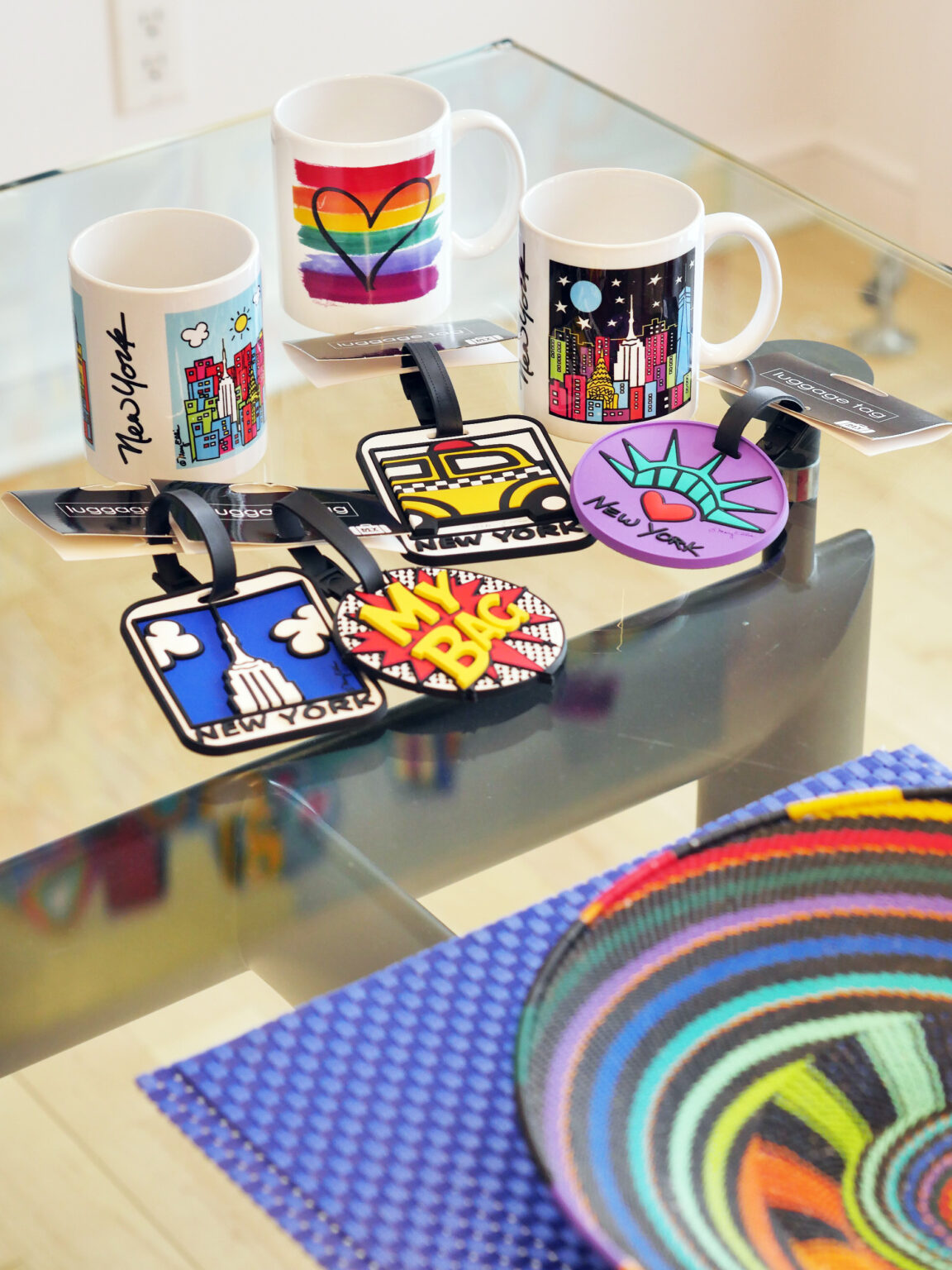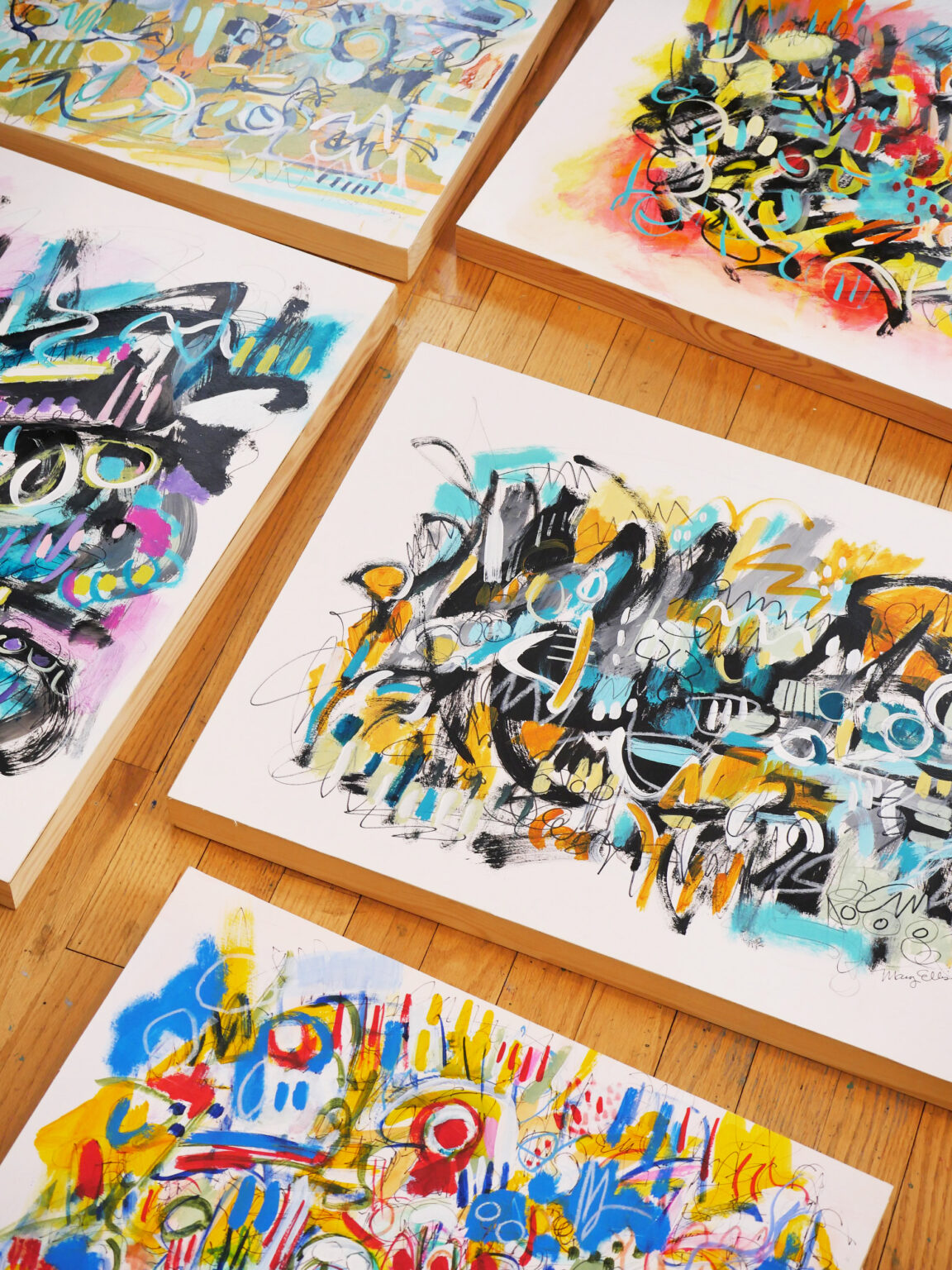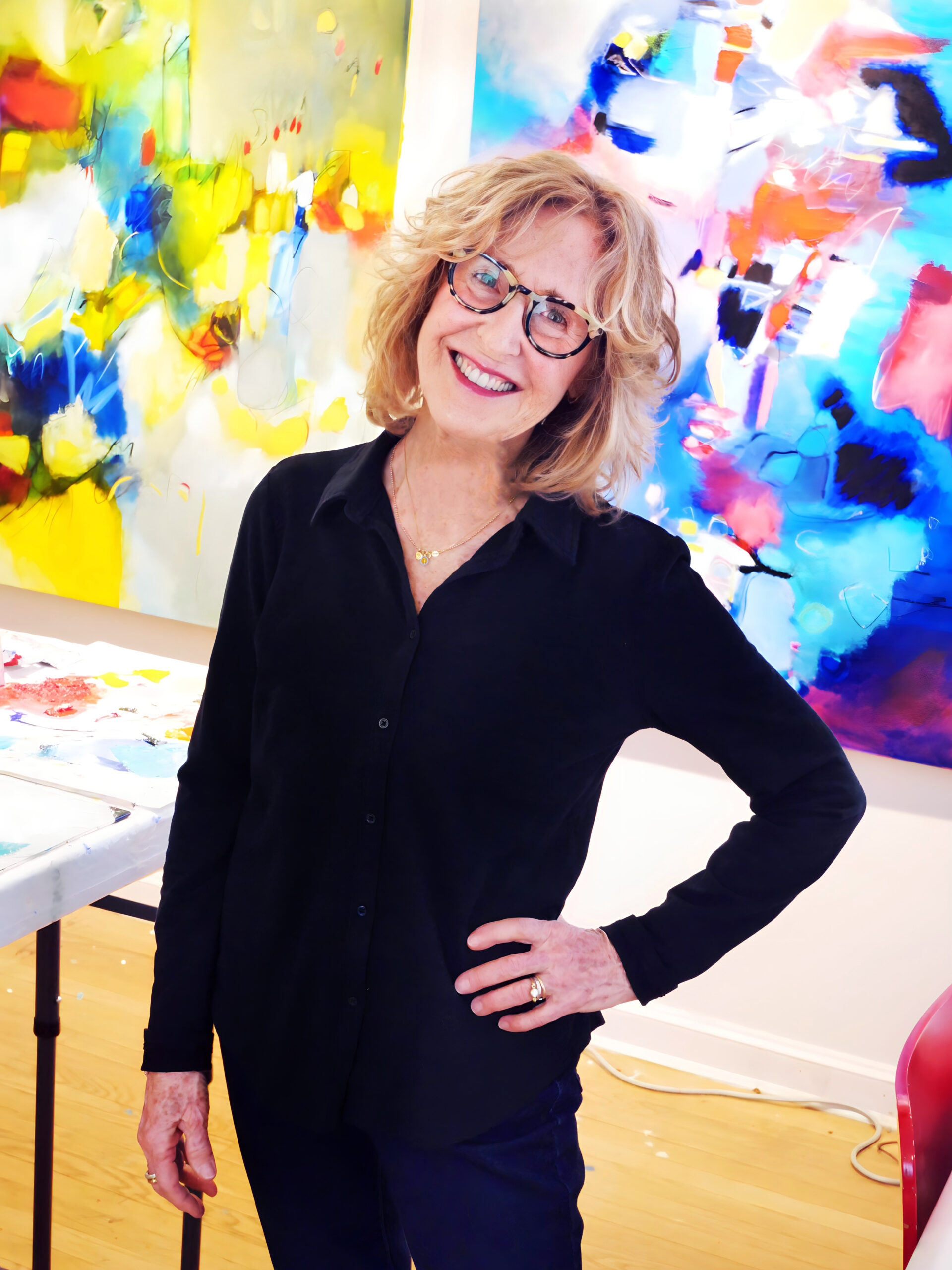Writing by Ava Fleisher
Photography by Justin Negard
This story begins when artist Mary Ellis was “very, very young.” An abstract expressionist painter and owner of Fifth Avenue Manufacturers, Ellis received support from those around her who could recognize her unique style. But throughout her childhood and adolescence, she struggled in school.
“I was told that I shouldn’t even apply to a four-year college,” she says.
Growing up in Manhattan, Ellis knew about the Pratt Institute, and despite the negative rhetoric from others, she applied and got in. It was the 1960s, and Ellis studied with many now-famous artists, like Alex Katz.
“The teachers that really encouraged me and were kind were the ones that made me feel the most comfortable, and I learned more from them,” she says.
However, Ellis also notes that during her freshman year, she, like most other students at the time, received low grades as motivation to improve.
“In retrospect, I think more support and kindness would have been a better way,” she explains. “I was made to feel that I had to really work hard and that nothing comes easy.”
After earning a B.F.A. in 1965, Ellis became an art teacher in New York City public elementary schools, an experience she describes as “pretty wild.” With few resources and low value placed on art teachers, it was a struggle to keep students engaged and on track. Ellis was what is referred to as a “cluster teacher”—one that often moves around from one age group or class to another throughout the day or week. She was given very few materials, and if the project didn’t excite the kids immediately, it was more difficult to keep their attention.
“I enjoyed teaching kids up to fifth grade the most because they were the most creative and not insecure,” she remembers. “They didn’t judge themselves.”
Meanwhile, Ellis took on additional work to financially support her personal art; one of those jobs was serving as a phone counselor for the first abortion clinic in New York City following the landmark U.S. Supreme Court decision Roe v. Wade. She took calls from and made appointments for people around the country seeking care.
A blank canvas
At the clinic, Ellis met a nurse who opened a new door for her as an artist.
“She was really into needlepoint, and she asked me to make her something,” Ellis remembers. “She didn’t want flowers or birds; she wanted something abstract, and that’s what I was into.”
From there, Ellis began creating more art on needlepoint canvases for her new friend, and the two opened a small store together in Greenwich Village, specializing in needlepoint.
“That’s how it all started, but I saw it was a very limited market,” says Ellis. “My friend [the nurse] lost interest, and I bought her out and ended up with the store.”
But with such a small market for needlepoint and a high volume of tourists in the area, Ellis transformed her store into a gift shop called Design Point by Mary Ellis. Like her paintings, the products were bright and abstract.
Of course, Ellis put her own creative spin on the business and began creating activewear with designs such as animal prints.
“It started with t-shirts and sweatshirts, and then it was a whole theme,” she explains. “You could come into my store and buy a duck t-shirt, a duck stuffed animal and a rubber duck. Everybody was into a particular animal.”
The shop expanded into a large wholesale company, and Ellis’ activewear was given entire sections in department stores like Macy’s. But running the business was so time-consuming that she had little left to focus on her art.
“I wasn’t into fashion; I was into the art that went onto the garments,” she says. “So for me, it became a monster. I had to design seasonally, which is what you have to do in fashion; coming from the gift world, that was a whole other world.”
Eventually, this constant turnover in design, combined with the challenges that accompanied creating/purchasing the correct amount of product per season and poor management, took its toll. Ellis closed her Greenwich Village shop and the wholesale company after about 15 years.

A new direction
After closing her businesses, Ellis still felt a strong desire to pursue her art. So, she attended wholesale shows at the Javits Center, where dozens of gift companies had booths.
“I just wanted to design and license my art, so I went to the Javits Center, and I’d look for companies that I thought would like my style, because I had a very particular style,” she says. “I’ve always had the ability to look at an object and make a line drawing that mimics it, so I could get the feel of what something was without doing a lot of sketching. My designs were simple, clean and bright. That was my style.”
Because she could capture the look and feel of subjects quickly and in an aesthetic manner, going from a simple sketch to the finished product was not overly time consuming. This skill appealed to other companies and made Ellis’ fresh designs even more sought after.
Ellis’ first licensing deal was with a company that sold paper plates, napkins and other party supplies in stores such as Party City. Her second licensing deal was with a larger company that sold mylar balloons.
From there, licensing Ellis’ designs took off, and she made a steady living creating art and selling it to other businesses to put on their products. It allowed her to focus exclusively on her art; the companies did the rest.
Ellis continued visiting the shows at the Javits Center regularly, and someone suggested she meet a man named Kenny Bookbinder from the company Big Apple Enterprises.
“I found him, and I thought it was kind of a strange name, Bookbinder,” she recalls. “But he knew who I was because he used to sell my store. He knew that I once had all these products in Macy’s.”
The two became friends, and Bookbinder asked for Ellis’ help with his showroom. With her experience in merchandising via her former store and her artist’s eye, Ellis helped organize products and develop Bookbinder’s logo.
“Then we started talking about how there was no real art on souvenir products,” she remembers. “It was always ugly.”
Whether it was the plain “I Love New York” logo or a simple statue, Ellis felt the designs on these souvenir products never really spoke to her, and she saw a major opportunity for visual improvement.
“[Bookbinder] was a manufacturer’s rep, so he sold products for all these companies,” she explains. “So he went to a mug company and gave them my design. I got the royalty, and he got the commission. And that’s how we started.”
Ellis’ work soon returned to Macy’s, but this time as souvenir products. The process of managing their abundant product line, however, was chaotic, to say the least. With separate manufacturers each making t-shirts, keychains or mugs, for example, organizing the production and shipment of the different products was a demanding task.
“We got this great order from Macy’s on the main floor, a whole department, and the buyers call us up screaming, ‘I got the t-shirts, but I didn’t get the keychains!’” she remembers. “And with all these different companies not shipping at the same time, that’s when we realized we had to bring it all into a warehouse and do it ourselves.”
Ellis and Bookbinder founded Fifth Avenue Manufacturers in 1994, and the two are now happily married.

Launching a business, take two
Fifth Avenue Manufacturers’ first location was in New York City near their showroom, but with such high rent, the two decided to move the warehouse up to Irvington, and they began commuting from the city to Westchester. Eventually, they relocated the business to Ossining, closer to where they now live in Briarcliff Manor.
Since then, Ellis says the business’ journey has been a “long, long road.” But their success remains unmatched. What started as a local New York souvenir business now creates products for 23 other states and Washington, D.C.
Their most popular products are typically keychains, sold in airport stores like Hudson News, but they also sell to the United Nations, the observatory at the top of the Empire State Building, the Museum of the City of New York and the United States Navy. In New York, their most iconic designs are taxis, the Empire State Building, the Statue of Liberty and the Brooklyn Bridge, all of which Ellis portrays with her bright and clean designs. She’s credited with transforming generally mundane souvenirs into artistic, dynamic memorabilia.
Today, Ellis still makes new designs for various states and cities, including a recent series for both Albany and Syracuse.
“Usually, I like working with a silhouette because I’m coming in and making it simpler,” she explains.
Ellis now creates all the art for Fifth Avenue Manufacturers digitally on a computer.

Returning to the canvas
The financial crisis in 2008, which was the deepest recession since World War II, left families and businesses grappling with economic concerns. But for Ellis, the crisis challenged her in another way: creatively.
“It had been fun because my husband and I would travel together to trade shows, but we were in trouble; the business was really struggling,” she recounts. “I realized I had to do something creatively. I had to find a way to be fulfilled, separate from the business. I needed to get back in touch with my center and my passion, so I just started painting.”
Initially, Ellis returned to the canvas, drawing and painting some of her pre-existing designs from Fifth Avenue Manufacturers. Looking back, she attributes this to apprehension.
“I was so afraid to go near paint; I hadn’t painted in so long,” she says.
At Pratt, Ellis had used oil paints, but when she began painting again, she turned to acrylics.
“I had to learn, so I spent a lot of time learning and experimenting with the materials,” she says.
Through trial and error, Ellis slowly moved back into her flow of painting and broke out of her decades-long shell. Then, she embarked on a 100-day challenge she discovered on Instagram. She promised herself that she would paint every day for 100 days, which accelerated her creativity.
“It built my confidence, and I felt empowered that I had that discipline,” she says.
With this newfound imaginative and committed attitude, Ellis was consistently painting in the studio before she knew it.
Today, each painting starts with a pencil, ink and/or graphite—a black-and-white drawing with little guidance. Sometimes, Ellis even uses her non-dominant left hand in these initial sketches, as she “just plays with the material.” At other times, she’ll add water to these materials, and once a base sketch is done, she moves on to applying very thin layers of paint.
“What’s tricky is that sometimes I stay within the initial drawing, and sometimes it’s totally gone,” she explains. “So, it’s a matter of layers. Sometimes I spend a lot of time adding and removing—just putting things down and taking them away and painting on top of them.”
Instead of a linear process, Ellis’ approach involves countless versions of the same piece. She says viewers can see this journey in the finished product.
“I love the history, and you can see some of those original lines come through,” she notes. “My hope is that I can bring you in and take you on my adventure.”

A spiritual and emotional connection
For Ellis, creating art goes deeper, affecting her spiritually. She describes her artistic process as “an energy” that shines through her work, not only from the original lines often seen in her pieces, but also through the bright colors and dynamic shapes she incorporates.
“It’s very emotional; when I’m painting, I have to be present,” she explains. “This is why I paint, actually, because I want to be in the moment, and I really try to bypass my mind and just stay in my heart.”
This emotional introspection has recently yielded a “groove,” as Ellis describes it, which allows her to create pieces she’s proud of, pieces that speak to viewers through the energy the work conveys.
Every year, however, Ellis’ style and skill continue to evolve, and that groove she’s in takes on a new and improved form. She says if she were asked a year from now, she would still say she was in that groove—just in a different, better way.
During the COVID-19 pandemic, Fifth Avenue Manufacturers, a business reliant on tourism, took a hit. But Ellis continued to channel her energy into her art, experimenting again. This time, she began using large pieces of paper in lieu of canvases because she felt that paper was both easier to work with and that the paintings done on paper jumped off the page more; these paintings felt more personal compared to traditional canvases.
“Because canvases are so unwieldy, I made these big paper paintings,” she explains. “There’s probably one or two paintings I think are the best paintings I’ve ever done in my life. It was a very difficult time, but I was very excited to work.”
Today, Ellis continues to paint on large pieces of paper, and she has also begun working with cradled wood panels—they are her two favorite materials.
Looking ahead
Ellis’ new exhibition, “Mary Ellis Now,” will be on display at Yellow Studio in Cross River from April 14 through May 10. It’s a collection of about 25 paintings she created over the past three years, including those made during the pandemic.
These paintings will display Ellis’ “whole new level of expression,” which she defines as “allowing her inner voice to show through her work.”
Ellis’ works are regularly on display at the Bethany Arts Community in Ossining, a community she initially joined during the pandemic to help combat the isolation.
And then there’s still Fifth Avenue Manufacturers, which has made a comeback since the height of the pandemic. Ellis continues to run the business with her husband, Kenneth, and her son, Noah Baumwoll, who is a sculptor. That business, she says, always comes first.
With Ellis’ return to painting in 2008 and recent breakthrough in her art, Ellis says she feels creatively fulfilled and wishes to “just keep painting” her energetic and uplifting pieces.
“Just join me in my adventure and move around in this space with me.”
This article was published in the March/April 2024 print edition of Connect to Northern Westchester.


Ava Fleisher
Ava Fleisher is Connect To's star intern and a local high school student. When she’s not writing, you can find her spending time outdoors, reading, or volunteering in her community. When she grows up, she would like to pursue a career in journalism and travel the world.










